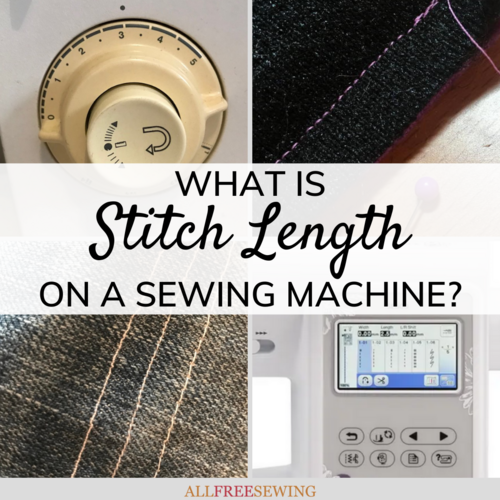What is Stitch Length on a Sewing Machine?
Learn the basics of stitch length, how to set stitch length on a sewing machine, and more with this helpful sewing guide.
Have you ever seen the term "stitch length" on a sewing machine and wondered what exactly it means? It's a little number in size but very crucial for successful sewing.
So, what is stitch length on a sewing machine?
All sewing machines have a setting that changes the length of the stitch you're sewing with but it's difficult to know how and when to change it, plus what it actually changes.
Although this resource helps beginners figure out details such as standard stitch length and width, even the more experienced sewists might need some of this information as well.
Below, learn the answer to what is stitch length, find out how to adjust stitch lengths, when to use short stitch lengths, when to use long, and a few more tips to help you achieve your sewing goals.
That's right, learn every about stitch length by following this guide for answers.
Sign Up For More Free Resources and Patterns >>
What is Stitch Length on a Sewing Machine?
Whether you're a beginner with sewing on a machine or you've been using one but aren't quite sure how to adjust the settings, learning about the stitch length dial function is going to help you sew your next project correctly with the proper spacing between stitches.
By the way, do you want to be a stitch pro? Learn the types of sewing machine stitches here. You can also learn how to end a sewing stitch on a machine here.

What is Stitch Length and Why is it Important?
"Stitch length" refers to the size of each individual stitch made with the sewing machine's needle and thread. It is important because the success of a line of stitching depends on it being correct.
If the stitch length is wrong the fabric could bunch, the threads could snap, and the overall look of the project will be less appealing.
The way to set the stitch length can vary slightly from machine to machine, but the standard numbering system works almost universally.
Most machines go from 0-5, with stitch lengths of 2-4 being the most commonly used. The numbers refer to the length of the stitch in millimeters (mm).
How to Set Stitch Length on Sewing Machine
When it comes to adjusting stitch lengths, it's critical to remember that every sewing machine is a bit different.
The exact knobs and buttons to adjust can vary. In general, stitch length can be adjusted on the front of the sewing machine with either a manual knob or on a digital display (for newer machines). You can see a manual dial on the left and a digital screen on the right in the image below.
Be careful not to confuse the stitch length setting with a machine’s tension. Some projects will require different stitch sizes for different areas of the same garment.
For instance, higher numbers might be used for setting in a sleeve, and medium-range settings for the rest. Follow a pattern’s instructions about stitch length if it is included.
When to Use a Short Stitch on Sewing Machine
The lower the number on the sewing machine the shorter (or "tighter") the stitch. Stitch lengths of 1 and 2 are closer together than higher numbers.
Short stitch numbers work best on lightweight, delicate fabrics. If the length setting is too short then the fabric will wrinkle or bunch up.
Stitch length 0 is used occasionally for making strong thread connections in one place (also known as lock stitching).
When to Use a Long Stitch on Sewing Machine
Longer stitch lengths will have a higher number on the sewing machine. They are useful for thick, bulky fabrics (like fake fur) that need extended amounts of thread to get through the fibers.
Lengths of 5 are used primarily for basting (or tacking), gathering, and temporary stay stitches that will later be pulled or removed.
If a stitch length is too long you’ll be able to see the stitches appearing loose or sagging. Stitch lengths can be easily tested on a scrap piece of fabric. This is especially helpful if you’re using a new sewing machine.
Keep this guide handy for your next sewing project!

